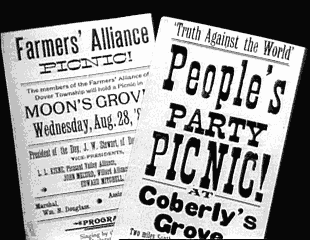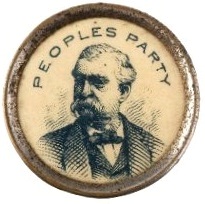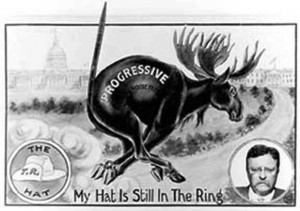Akim - Google Blog Search |
| American Duopoly, Part II: Populist and Progressive Challenges to <b>...</b> Posted: 20 Nov 2013 07:32 AM PST This is Part II of a three-part essay examining the history, causes, and possible responses to the dominant two-party system in American politics. It originally appeared at 3 Quarks Daily.
Formed around farmers in the South and Midwest who, in a variety of ways, were deeply troubled by the rise of capitalism, Populists focused on issues of debt, currency reform, and the strict regulation of big business, up to and including the proposed government seizure of corporate land for redistribution to the public, government-owned alternatives to private banking, and even government-run monopolies on vital industries such as communications. That's right. Several generations ago, many of the people in what are today the reddest, most Republican, free-market, Tea Partying parts of the United States, actually advocated socialistic reforms to combat the consolidating effects, crushing debt, and boom-bust cycle of capitalism. They even championed a constitutional amendment to allow for the introduction of a national income tax. The Populists ran James B. Weaver for President in 1892. He garnered over a million popular votes (8.5%) and 22/444 electoral votes. The upstart party was poised for a potential breakthrough in 1896, but the Democrats stole the Populists' thunder by nominating William Jennings Bryan, who co-opted many of their issues. After substantial debate, the Populists also nominated Bryan in absentia, though he failed to acknowledge them. After Bryan lost the presidency to William McKinley, the People's Party faded as a national concern. However, over the course of the 1890s they managed to win nearly a dozen state governorships, several dozen Congressional elections, including half a dozen U.S. Senate seats, and scores of seats in various state legislatures. The next major challenge to the duopoly came from the short lived Progressive Party, also known as the Bull Moose Party, which resulted from a schism among Republicans during the 1912 presidential election. Theodore Roosevelt had stepped down from the presidency in 1909 after nearly two-full terms in office, and been replaced by his hand picke By 1912, the United States was at the height of its great period of reform, the Progressive Era, which the Populists had anticipated in many ways. Bubbling up during the 1890s, progressivism grew into a wide ranging set of social movements during the first two decades of the 20th century. America was awash with countless reform movements advocating everything from business regulations and labor rights to women's suffrage to political reform to the prohibition of alcohol. While Roosevelt's Progressive Party received only spotty support from Republican stalwarts, independent and loosely affiliated reformers flocked to it. The party's platform called for a host of prescient, progressive reforms, including some which had been advocated by the Populists. Among them were: the registration of political lobbyists; the disclosure and regulation of political campaign contributions; social security; an eight hour workday; a minimum wage; a securities exchange commission; worker's compensation for job-related injuries; a constitutional amendment allowing for a federal income tax; an inheritance tax; a constitutional amendment allowing for the direct election of U.S. Senators; and binding primary elections. The Progressives were also the only party in 1912 to support constitutional amendment guaranteeing women's suffrage. And during the heyday of Jim Crow racial apartheid, Roosevelt inflamed racists by inviting black delegates from outside the South to his convention, and by publicly dining with African Americans. But like the Populist James Weaver 20 years earlier, even Teddy Roosevelt was unable to pull off a third party presidential bid. However, he did capture the second biggest portion of popular votes at 27%, ahead of Taft. Yet another third party candidate, Socialist Eugene Debs, took another 6%. On the electoral map, TR accrued 88 electoral votes, while Taft managed to win only 8. But Democrat Woodrow Wilson took the lion's share of electoral votes to win the p It's been a century since the decline of the Progressives, and since then, no third party has been able to gain the level of support that either they or the Populists accrued. But that does not mean it's impossible. In the final part of this essay, we'll look at some unorthodox strategies that could possibly help give a leg up to the two biggest minor parties in today's political scene: the Green Party and the Libertarian Party. Filed under: American History, Politics |
| You are subscribed to email updates from Akim - Google Blog Search To stop receiving these emails, you may unsubscribe now. | Email delivery powered by Google |
| Google Inc., 20 West Kinzie, Chicago IL USA 60610 | |



Tiada ulasan:
Catat Ulasan